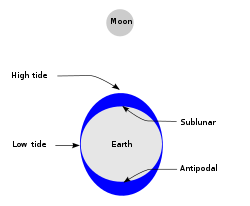Tidal Energy: Technology to convert the energy from tides into useful forms of power
Tidal energy, sometimes called tidal power, is using the energy contained in moving water in tides and open ocean currents for hydroelectricity.

Tidal energy systems can extract either kinetic energy (energy caused by movement) from the moving water of rivers, tides and open ocean currents; or potential energy from the difference in height (or head) between high and low tides. The first method - generating energy from tidal currents - is becoming more popular because people believe that it does not harm the environment as much as barrages or dams. Many coastal sites worldwide are being examined to see if they can be used to produce tidal (current) energy.

Like other hydroelectricity (electricity made using water), tidal power produces no pollution and is a renewable energy source, because tides are caused by events that happen in the solar system and so will not run out. Tidal power has great potential for future power and electricity generation because of the very large amount of energy contained in these rotational systems. Tidal power is reliably predictable (unlike wind power and solar power). In Europe, tide mills have been used for nearly 1,000 years, mainly for grinding grains. Modern tide mills provide tidal stream power.
Many things affect tides. The pull of the Moon is the largest effect, and most of the energy comes from the slowing of the Earth's spin.
Sources
- Baker, A. C. 1991, Tidal power, Peter Peregrinus Ltd., London.
- Baker, G. C., Wilson E. M., Miller, H., Gibson, R. A. & Ball, M., 1980. 'The Annapolis tidal power pilot project', in Waterpower `79 Proceedings, ed. Anon, U.S. Government Printing Office, Washington, pp 550-559.
- Hammons, T. J. 1993, 'Tidal power', Proceedings of the IEEE, [Online], v81, n3, pp 419-433. Available from: IEEE/IEEE Xplore. [26 July 2004].
- Lecomber, R. 1979, 'The evaluation of tidal power projects', in Tidal Power and Estuary Management, eds. Severn, R. T., Dineley, D. L. & Hawker, L. E., Henry Ling Ltd., Dorchester, pp 31-39.

This article uses material from the Wikipedia Simple English article Tidal energy, which is released under the Creative Commons Attribution-ShareAlike 3.0 license ("CC BY-SA 3.0"); additional terms may apply (view authors). Content is available under CC BY-SA 4.0 unless otherwise noted. Images, videos and audio are available under their respective licenses.
®Wikipedia is a registered trademark of the Wiki Foundation, Inc. Wiki Simple English (DUHOCTRUNGQUOC.VN) is an independent company and has no affiliation with Wiki Foundation.
